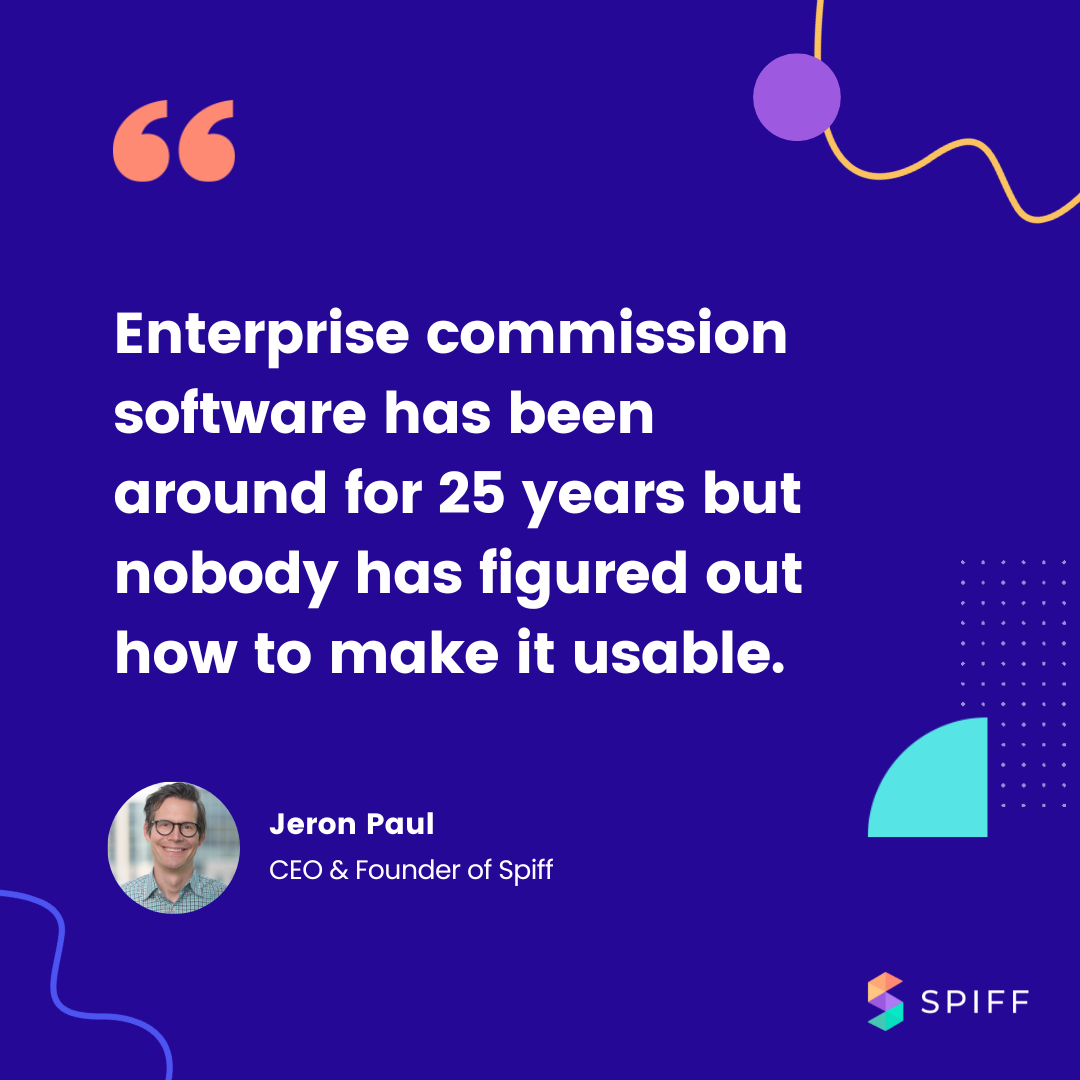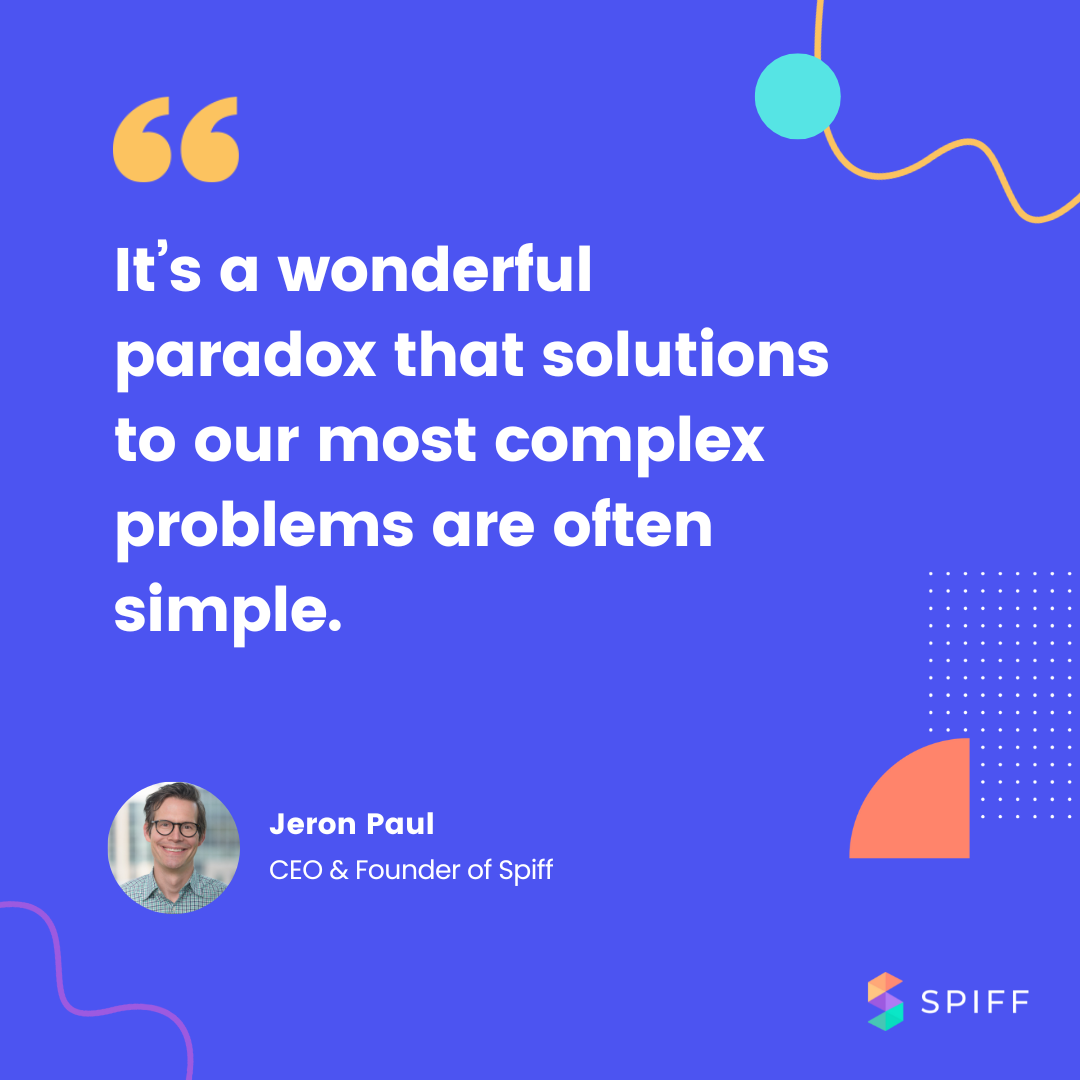For decades, perhaps longer, organizations of all sizes have struggled to effectively manage sales commission. Look up any organization with a sales team on a reputable employer review site and you’ll likely find at least one review, if not several, citing late, inaccurate, confusing, or constantly changing commission pay as a major criticism.
Commission management is a universal thorn in the side of finance organizations, RevOps teams, and commissioned employees across organizations everywhere.
In today’s blog post, we’re going to get to the bottom of this phenomenon and answer the following questions:
- Why has sales commission been such a persistent problem?
- How are the most widely accepted commission solutions still missing the mark?
- What is the true solution for organizations struggling through manual or tedious commission cycles?
And, finally, we’ll share a sneak peek at something we believe will change the future of commission management forever.
Let’s get into it!
Why has sales commission been such a difficult problem to solve?
Despite significant innovation in the worlds of compensation management and financial modeling, sales commission remains one of the most difficult processes to solve for in modern business.
But, why? In the age of artificial intelligence and machine learning, what is it about sales commission that businesses find so difficult to wrangle?
While there isn’t a singular “right” answer to this question, we can point to a few factors that make commission management complex, difficult, and time-consuming– no matter how it’s done.
Complicated Team Dynamics
Sales teams, particularly those at hyper-growth organizations, startups, and enterprise-level businesses, are complex. Most sales teams have a business development arm and an account executive team. Within those two organizations there is often further division– inbound vs. outbound, mid-market vs. enterprise, and so on and so forth.
Then, you also have commissioned employees who sit outside of the sales team– sales engineers, account management, support, service roles, and more. Each of these team units and subunits is compensated for different behaviors and activities. For example, an organization may compensate an Outbound SDR for the number of meetings they book. Whereas, an Account Executive might be compensated a percentage of their closed won revenue.
If done correctly, an incentive compensation strategy is tailored to each particular role so that it drives more of the right outcomes. This often means: the more complex the sales team, the more complex the organization’s pay structure will be.
Complex Commission Structures
Every organization, industry, and business model varies when it comes to sales compensation. But, after a certain stage of growth, a common thread across most compensation structures is complexity.
The reason for this is simple: a sales compensation structure has multiple goals– the most common include driving revenue, motivating employees, and incentivizing specific behaviors. In order to accomplish several nuanced goals across complex team structures, organizations often leverage compensation tactics like commission caps, draws, clawbacks, tiers, accelerators, and others.
Although these tactics can be effective in moderation, the more layers a comp plan contains, the more difficult it becomes to track, understand, and, later, to communicate the details to employees.
Multiple, Disparate Data Sources
Calculating commission payouts each pay period requires access to several complex data sets– all of which may be housed in a different system. Whether you’re pulling from a CRM, an ERP, or a complicated tangle of spreadsheets, consolidating data from multiple sources can be a nightmare– particularly at scale.
When systems of record aren’t connected, they operate independently of one another. This means there is no single source of truth to draw data from. The end result? Inaccurate pay, reporting errors, friction across departments, loss of productivity, lengthy commission processing times, and more.
Constant Change
In the world of incentive compensation, the only constant is change. The number of factors that impact a commission plan are virtually endless– new product launches, market shifts, restructuring, territory changes, new hires, lay offs, quota adjustments. You get the point.
So, not only are team dynamics and commission structures already complicated, but they’re also constantly changing. In order to keep up with these changes, organizations require a solution that is self-manageable, immediately accessible, and easy to use– but at the same time powerful, integrated, and flexible.
It’s a tall order.
How are the most widely accepted commission solutions still missing the mark?
There are two widely accepted types of solutions used to carry out commission management– spreadsheets and legacy commission automation. While each have their advantages, both also come with some serious drawbacks– leaving organizations to choose between the lesser of two evils.
Let’s explore the pros and cons of each.
The Commission Spreadsheet
Spreadsheets get a bad rap– we’re even guilty of contributing to the negative press surrounding Excel and similar tools. But, the truth is, spreadsheets are a powerful and useful tool to keep in your arsenal for a wide range of work. But, as we’ll dive into, they simply weren’t created to manage sales commission programs at scale.
The Pros of the Commission Spreadsheet
There’s a reason why so many organizations– both large and small– continue to manage sales compensation in a spreadsheet.
- Familiarity: Spreadsheets have been a staple in the world of business for decades. Because of this, students are taught and expected to use spreadsheets as early as high school– making them as familiar as programs like Microsoft Word or Google Docs.
- Ease of use: Spreadsheets are incredibly easy to use– due in part to early exposure and education, but also because they were created to be used by a wide range of people for a variety of tasks.
- Transferability: Spreadsheets are universally known by people of all walks of life, across all ages and all job functions. Organizations and businesses everywhere supply most employees with a basic spreadsheet program like Excel or Google Sheets regardless of their role.
- Accessibility: There is no barrier to entry with spreadsheets. The cost is minimal, most companies already have access to a spreadsheet program, and anyone with access can immediately start building– no down time, no waiting, no relying on outside vendors.
The Cons of the Commission Spreadsheet
Would it shock you to learn that neither Microsoft nor Google use their own spreadsheet software to manage their commission plans? Despite the universal nature of spreadsheets, they come with some major drawbacks that make them insufficient for commission management.
- Not built for sales compensation: Spreadsheets don’t integrate with source data, user management is nearly impossible, knowledge of an organization’s commission process is typically owned by just one or two people, and quick changes are nearly impossible.
- Error-prone: Because data input and calculations are largely manual processes, human errors are inevitable and frequent. And, fixing those errors? Good luck finding the offending formula or missing data in your nest of spreadsheet tabs.
- Inefficient: Checklists, record keeping, and multi-step dispute resolution procedures are all necessary parts of a spreadsheet-based commission process.
- Lack of real-time data: Because spreadsheets don’t integrate with ERP, CRM, or other systems of record, data is never entirely accurate or updated in real-time. The second data is imported into a spreadsheet, it begins to decay.
The Legacy Commission Automation Platform
When companies realize spreadsheets no longer serve their purpose when it comes to commission management, they seek out alternatives. But, just like the spreadsheet, legacy solutions aren’t perfect.
As Jeron Paul, Founder and CEO of Spiff puts it, “Enterprise commission software has been around for 25 years but nobody has figured out how to make it usable.”

The Pros of the Legacy Commission Platform
Let’s first look at what legacy solutions have gotten right:
- Automated: To their credit, most legacy vendors handle logical and mathematical complexity better than the standard spreadsheet.
- Integrated: Although integrations vary across vendors, it’s safe to say that most legacy systems handle integrations with source systems better than a spreadsheet.
- Real-time data: Because legacy systems have better integration capabilities, data is updated more frequently– though this also depends on the vendor and how fast their technology can process large amounts of data.
The Cons of the Legacy Commission Platform
Now, let’s look at the things legacy commission vendors got wrong.
- Steep learning curve: Most legacy vendors require custom ETL programming and users must learn a proprietary logic language to even begin using the system.
- Not universal: Unlike the spreadsheet which is widely used across organizations, legacy commission automation isn’t ubiquitous. So learning one platform won’t help someone who takes a role at an organization that uses a different platform.
- Inflexible: Due to their complex nature, legacy systems have long implementation times, difficulty managing change, and are overly reliant on professional services.
The Great Divide Preventing Widespread Adoption of Automation
Despite commission management being a problem for decades, automation adoption isn’t as widespread as you’d think. And this all comes down to one thing: usability.
Where the spreadsheet is strong, automation is weak. Where automation is strong, the spreadsheet is weak. This leaves us with an overwhelming gap. And, it also means too many organizations are relying on ill-fitting solutions to their commission problems. It’s a lose/lose scenario.
Bridging the Mental Model Gaps to Create the Ideal Commission Solution
Paul again explains this divide brilliantly, “It’s a wonderful paradox that solutions to our most complex problems are often simple,” citing Jerome Bruner, renowned American psychologist who once said great solutions often have a “quality of obviousness…producing a shock of recognition following which there is no longer astonishment.”

Paul continues, “The key to finding these simple solutions is to see the problem in a new way. So it’s more accurate to say that solutions to our most complex problems are often simple in hindsight. After being shown Darwin’s theory of evolution, Thomas Huxley could only say ‘How extremely stupid not to have thought of that.’”
To solve the problem of commission management, the ideal solution combines the positive attributes of the spreadsheet with the positive attributes of legacy automation. Ease-of-use and power, in a single solution.
Introducing Spiff Designer
This week, we announced the launch of a brand new Spiff Designer– our newest backend model builder. This launch means that, for the first time ever, organizations will have access to a commission solution that has the power of a full-blown coding language and the ease-of-use of a spreadsheet.
The innovation behind this launch hinges on the idea of simplicity, and it’s delivered in three ways:
- Spreadsheet-like usability. Spreadsheets are the original financial automation platform. Spiff Designer mirrors the familiarity and ease-of-use of a spreadsheet.
- Object- and spreadsheet-oriented. Financial systems-of-record are object-oriented, not spreadsheet-oriented. This is why spreadsheets fail at scale. Spiff merges the usability of spreadsheets with the power of Objects. In Spiff, you can reference any connected Object using the same language you would use in the source system itself.
- Modern-coding platform. Spiff uses innovations from coding languages to merge into its familiar spreadsheet interface. Spiff is a modern Integrated Development Environment featuring typeahead and AI-driven logic simplification tools.
Ultimately, Spiff Designer makes self-management possible, reduces the learning curve associated with commission software, enables painless change management, and ultimately allows for productivity, accuracy, and efficiency at scale.
Take a self-guided tour of Designer, here.
The Future of Commission Management is Here
We’ll wrap this up with a final word from Spiff CEO and Founder, Jeron Paul:
“John Adams was one of the early voices for independence in the 13 original colonies that became the United States. Speaking about the quest for independence, he said: “If we finally fail in this great and glorious contest, it will be by bewildering ourselves in groping for the middle way.”
When dreaming big reveals big challenges, we often dream smaller. Dreaming big will always reveal big challenges. The paradoxical answer is to dream bigger. Part of the problem of legacy commission vendors is that they didn’t dream big enough. Faced with endless permutations of commission plans, they tried to simplify by creating a proprietary language and ramping up professional services.
Spiff’s response is not just to automate commissions but to ultimately replace the spreadsheet. Our Definition of Victory is to automate every mathematically and logically-intensive financial process in real-time.
Every company handles commission management differently because every company has a different strategy and win conditions. Spiff wasn’t able to solve this ease-of-use problem overnight. It’s taken us about 5 years but I can confidently say Spiff Designer is the easiest-to-use enterprise-grade product on the market and it’s only getting easier even as we add power from here. Spiff offers power without complexity.”

With that, we welcome you to the next chapter of Spiff. We can’t wait to show you what we’ve been working on.
About Spiff
Spiff is a new class of commission software that combines the familiarity and ease-of-use of a spreadsheet with the power of automation at scale- enabling finance and sales operations teams to self-manage complex incentive compensation plans with ease. Spiff is designed to facilitate trust across organizations, motivate sales teams, increase visibility into performance and earnings, and ultimately, drive top line growth. The platform’s intuitive UI, in-depth reporting capabilities, and seamless integrations make it the first choice among high-growth and enterprise organizations.






